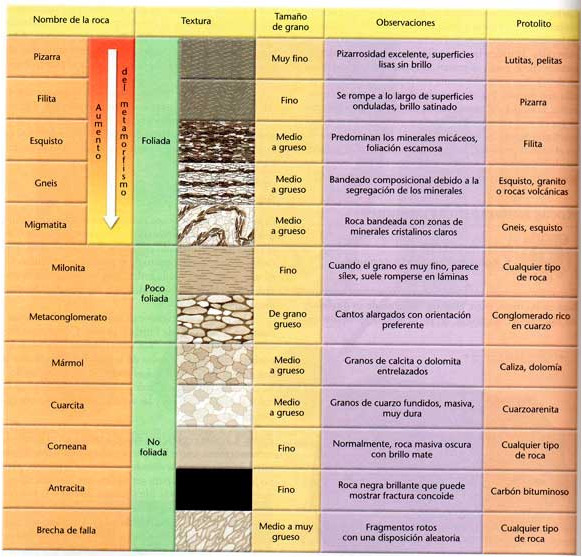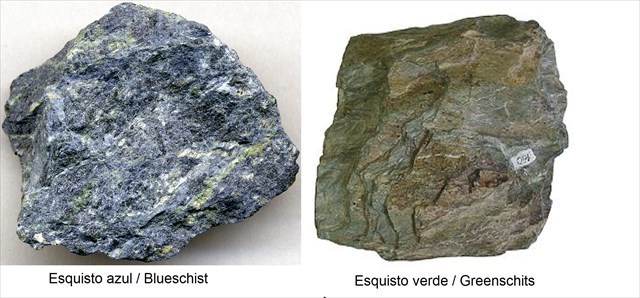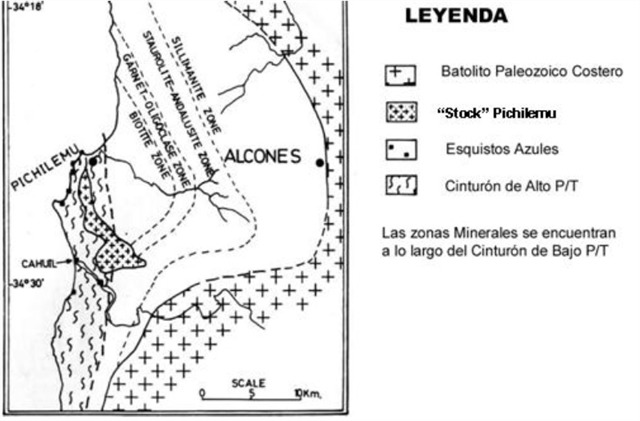El esquisto es una roca metamórfica que está compuesta de granos minerales que están más o menos alineados en capas. Debido a esta estructura, el esquisto tiende a escindirse en placas o escamas.
La roca madre de un esquisto puede ser ígnea (por ejemplo, basalto, granito, sienita) o sedimentaria (por ejemplo, arenisca, caliza). El grado metamórfico de un esquisto depende de lo bien fundido y recristalizado que ha sido su roca madre. Las temperaturas más altas producen menor contenido de agua, una cristalización más gruesa, capas más distintas y escisión reducida. En el extremo superior de esta escala, los esquistos se difuminan en los gneises.
Schist is a metamorphic rock that is composed of mineral grains that are more or less aligned in layers. Because of this structure, schist tends to cleave into flakes or slabs.
The parent rock of a schist can be igneous (eg, basalt, granite, syenite) or sedimentary (eg, sandstone, limestone). The metamorphic grade of a schist depends on how well molten and recrystallized its parent rock has been. Higher temperatures produce lower water content, thicker crystallization, more distinct layers and reduced cleavage. At the upper end of this scale, the schists fade into the gneisses.

Clasificación de rocas metamórficas comunes/ Common metamorphic rocks classification
Durante la formación de un esquisto o gneis, la roca madre se calienta lo suficiente como para movilizar sus átomos. A medida que se enfría bajo una tensión anisotrópica, sus átomos asumen las disposiciones más estables y de baja energía disponibles: cristales anisotrópicos (placas o formas alargadas que apuntan en una dirección común). La estructura cristalina anisotrópica da a los esquistos sus clásicas características de escisión.
Hay muchas variedades de esquisto. Dos categorías son las más importantes: El esquisto verde y el esquisto azul. Éstos tienen rocas parentales similares, pero se forman bajo diferentes condiciones de presión y temperatura. Los esquistos verdes se forman bajo presión alta y temperatura alta, las que se encuentran muy por debajo de la corteza terrestre, mientras que los esquistos azules se forman bajo presión alta y temperatura relativamente baja.
During the formation of a schist or gneiss, the parent rock heats up enough to mobilize its atoms. As it cools under anisotropic stress, its atoms assume the most stable and low energy dispositions available: anisotropic crystals (plates or elongated shapes pointing in a common direction). The anisotropic crystalline structure gives the schist its classic cleavage characteristics.
There are many varieties of schists. Two categories are the most important: The greenschist and the blueschist. They have similar parental rocks, but they are formed under different conditions of pressure and temperature. Greenschists are formed under high pressure and high temperature, which are well below the earth's crust, while blueschists are formed under high pressure and relatively low temperature.

Tanto los esquistos verdes como los esquistos azules se encuentran en paisajes metamorfosificados regionalmente, es decir, masas terrestres que han sido sumergidas enteramente en el interior de la Tierra y metamorfoseadas a granel.
La metamorfosis regional ocurre a menudo en las zonas de subducción, esos lugares en donde una placa tectónica se está conduciendo bordeando en el manto debajo de otro. Un trozo grande y fresco de la corteza de la Tierra toma mucho tiempo para alcanzar el ambiente temperatura cuando se sumerge en el manto, pero a su vez se eleva a una presión alta. Una masa subducida que permanece baja el tiempo suficiente para alcanzar tanto la temperatura alta como la presión alta, produce esquistos verdes, mientras que uno que vuelve a la superficie produce relativamente rápido produce esquistos azules.
Uno de los grandes enigmas no resueltos de la geología moderna es que la formación de esquistos azules parece haber llegado a ser globalmente más común en los últimos 300 millones de años, mientras que la formación del esquistos verdes ha permanecido constante a través de la historia de la tierra.
Both the greenschist and the blueschist are found in regionally metamorphosed landscapes, that is, landmasses that have been submerged entirely in the interior of the Earth and metamorphosed in bulk.
Regional metamorphosis often occurs in subduction zones, those places where a tectonic plate is being driven bordering on the mantle beneath another. A large, fresh piece of the Earth's crust takes a long time to reach the temperature environment when it is submerged in the mantle, but in turn rises to a high pressure. A subducted mass that remains low long enough to reach both high temperature and high pressure produces greenschists, while one that returns to the surface, relatively fast, produces blueschists.
One of the great unsolved enigmas of modern geology is that the formation of blueschists seems to have become globally more common in the last 300 million years, while the formation of greenschists has remained constant throughout the history of the earth.

Esquistos azules en zona de subducción / Blueschists in subduction zone
En el sitio que visitará en este Earthcaché encontrará unas rocas que pertenecen a un complejo metamórfico que aflora a lo largo de la Cordillera de la Costa de Chile (32º - 42ºS). Ellas se formaron a grandes profundidades y fueron sometidas a esfuerzos de gran magnitud, pues se enterraron 30 km, y hoy se encuentran en superficie, lo que ha llamado la atención de diversos investigadores nacionales e internacionales, quienes desde la década de los 70 buscan resolver las interrogantes sobre su origen y exhumación. Dataciones recientes indican que dichas rocas son de edad Paleozoica, es decir, se formaron hace 320 millones de años aproximadamente. En este complejo se reconocen dos unidades principales que difieren en gradiente metamórfico, estructura y protolito, llamadas Serie Oriental y Serie Occidental. La Serie Occidental posee una mineralogía característica de gradientes metamórficos de alta presión y baja temperatura, con litologías de procedencia oceánica, mientras que la Serie Oriental, la mineralogía es característica de gradientes metamórficos de baja presión y alta temperatura, compuesta de turbiditas de procedencia continental.
In the site you will visit in this Earthcache you will find some rocks that belong to a metamorphic complex that crops out along the Chilean Coastal Range (32º - 42ºS). They were formed at great depths and subjected to large-scale efforts, since they were buried 30 km, and today they are on the surface, which has attracted the attention of various national and international researchers, who since the 1970s have been trying to solve the questions about its origin and exhumation. Recent data indicate that these rocks are of Paleozoic age, that is, they were formed approximately 320 million years ago. In this complex, two main units are recognized that differ in metamorphic gradient, structure and protolith, called Oriental Series and Western Series. The Western Series has a mineralogy characteristic of metamorphic gradients of high pressure and low temperature, with lithologies of ocean origin, while the Oriental Series, its mineralogy is characteristic of metamorphic gradients of low pressure and high temperature, composed of turbidites of continental origin.

Zonas metamórficas en el área de Pichilemu / Metamotphic zone in Pichilemu area (Hervé et al, 1984).
La evolución geodinámica del basamento metamórfico paleozoico de la Cordillera de la Costa de Chile Central entre los 34 y 38°S se encuentra ligada a la subducción de la placa paleo-Pacífica bajo el margen occidental de Gondwana. Ella dio lugar a un complejo acrecionario que se desarrolló en el Carbonífero Superior. Este muestra características de un cinturón pareado metamórfico, en el que se distinguen dos franjas N-S que difieren en gradiente metamórfico y protolito. Se les ha llamado Serie Occidental (baja temperatura/alta presión) y Oriental (alta temperatura/baja presión). Las rocas que hacen referencia en este Earthcache se encuentra en la serie Occidental, la que dio origen a estos esquistos azules, entre otras interesantes estructuras.
The geodynamic evolution of the Paleozoic metamorphic basement of the Cordillera de la Costa of Central Chile between 34 and 38 ° S is linked to the subduction of the Paleo-Pacific plate under the western margin of Gondwana. It gave rise to an accretionary complex that developed in the Upper Carboniferous. This shows characteristics of a metamorphic matched belt, in which two N-S stripes are distinguished that differ in metamorphic gradient and protolith. They have been called Western Series (low temperature / high pressure) and Oriental (high temperature / low pressure). The rocks that refer to this Earthcache is in the Western series, which gave rise to these blueschists, among other interesting structures.
Para poder logear como encontrado este Earthcaché deberán responder las siguientes preguntas:
Punto 1. S34°23.655 W072°01.557
1. Describe con tus propias palabras, cual es el color predominante que se ve en esta roca
Punto 2. S34°23.656 W072°01.562
2. ¿Cuál es el color predominante en esta roca?
3. Acá podrá ver unas venas entre las láminas. ¿De qué color son estas venas?
4. ¿De qué mineral podrán ser estas venas? Este mineral es bastante común en la zona.
Punto 3. S34°23.661 W072°01.570
5. ¿Cuál es el color predominante en las rocas de este sector?
6. Tarea opcional. Tomarse una foto en el sector, pero sin revelar las respuestas.
Para registrar este Earthcache, envíe un mensaje a Team Kawesqar, dando las respuestas a estas preguntas. No los respondas en tu registro. Los registros sin respuestas de apoyo pueden ser eliminados.
In order to log this earth cache, you should answer the following questions:
Point 1. S34°23.655 W072°01.557
1. Describe in your own words, what is the predominant color that is seen in this rock
Point 2. S34°23.656 W072°01.562
2. What is the predominant color in this rock?
3. Here you can see some veins between the plates. What color are these veins?
4. From what mineral can these veins be? This mineral is quite common in the coastal area.
Point 3. Punto 3. S34°23.661 W072°01.570
5. What is the predominant color in the rocks of this sector?
6. Optional task. Take a picture of you in the area, but without revealing the answers.
To claim this Earthcache, send a message to the Team Kawesqar, giving the answers to these questions. Do not answer them in your log. Logs without supporting answers may be deleted.